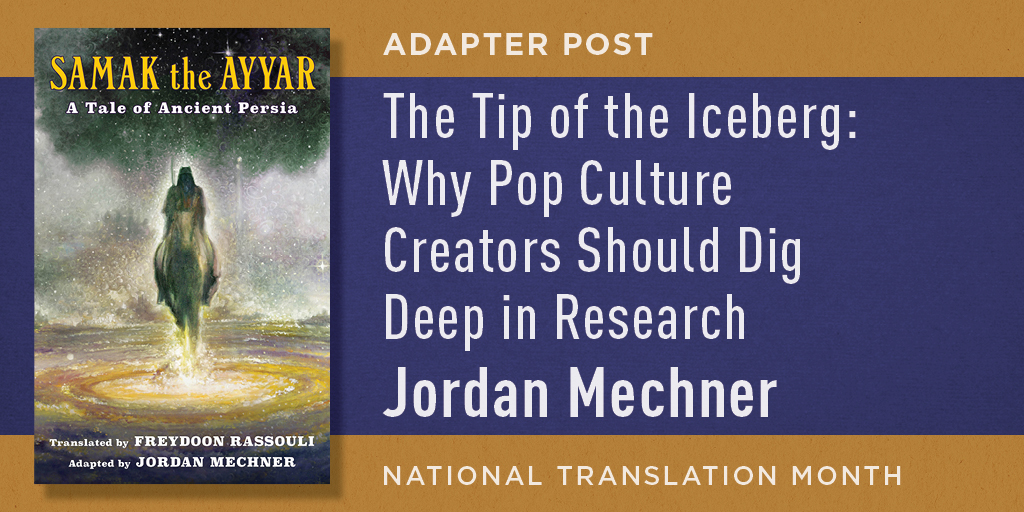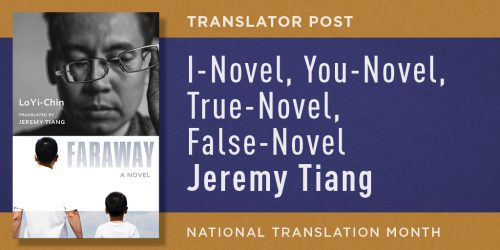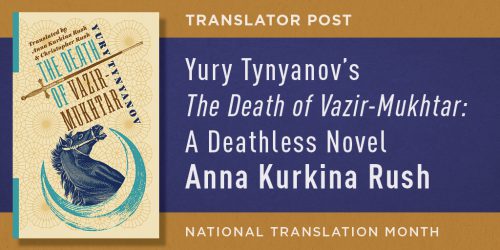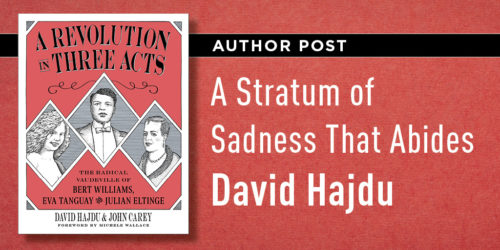The Tip of the Iceberg: Why Pop Culture Creators Should Dig Deep in Research By Jordan Mechner

When I build a fictional world for a book, video game, or film/TV project, I spend months doing research. Whether the setting is history, fantasy, or the present day, my research investments always pay huge creative dividends.
People sometimes think of research as getting details right—names of streets and flowers, how people are dressed, what kind of gun an FBI agent carries. But avoiding mistakes that could pull a reader out of the story is only the most superficial level of research. Counterintuitive as it might seem, deep research is the source of originality.
THE TELLING DETAIL
If a fictional universe feels coherent and rich, it’s not because the writer has crammed it full of details. It’s rare that a character’s shoes or the model of their sidearm matter to the story. Things that don’t matter are usually best left out.
There’s a world of difference between not mentioning a detail because it’s unimportant and not mentioning it because you aren’t sure what it would be. Readers sense confidence and the lack of it. To choose a detail that economically conveys meaning in a specific story situation, you need to know your world well enough to consider and discard a wealth of less-effective options. What ends up on the page or screen is the tip of the iceberg of what you know.
When creators skimp on research, the result is cliché—generic characters and dialog, situations we’ve seen before. Most of what bubbles to the surface of our imaginations is deeply unoriginal.
THE POWER OF ROTOSCOPING
Illustrators and artists know the value of references and aren’t embarrassed to use them. When the impressionists painted landscapes en plein air rather than trying to recall and simulate nature in the studio, they found new ways to capture what they saw on the spot. Despite the new style’s sketchiness and economy of brush strokes, it evoked reality as vividly as detailed academic paintings of the past.
This lesson was brought home to me when, as a teenager, I struggled to create believable animation for my first video games. My attempts to make characters run and jump were unconvincing: programmer art. It wasn’t until I filmed a real person and rotoscoped the footage frame by frame that my pixelly character achieved the illusion of life I’d been unable to conjure from memory.
The rotoscope principle works for creators of fiction in all media. Our brains are cluttered with clichéd images of places we’ve never visited, people whose shoes we’ve never walked in. Reality challenges our preconceptions, replaces stereotypes with details we couldn’t invent. Real life is an inexhaustible free resource of things that are true.
AN OPEN MIND
I love the way research leads me not only to answers but also to new questions, often more interesting than the ones I started with. My graphic novel Templar was born out of research for a different project; what I discovered about the actual fourteenth-century Knights Templar compelled me more than the modern-day conspiracy plot I’d been hatching. The ancient Persian adventure tale of Samak the Ayyar was unknown to me until my collaborator Rassouli brought it to my attention during research for a Prince of Persia video game. That game never got past preproduction, but our translation and adaptation of the story of Samak is now a 450-page paperback.
To leave room for serendipity, I start research early in a project. For an upcoming graphic novel about global finance, law enforcement, and counterterrorism, I read a stack of memoirs by former FBI agents and directors, defense attorneys and prosecutors, Guantánamo prisoners, and participants in recent political, business and financial scandals—a crash course in the modern world. Their real-life experiences pushed my plot and characters in directions my pre-research outlines hadn’t considered.
DIGGING DEEPER
Today, search engines and Wikipedia make research so easy, it’s tempting to believe I can answer all my questions on the internet without leaving home. But I’ve found so much value in pushing past that boundary that I urge anyone who’s serious about world-building—even if you’re an introvert like me—to take these next steps:
- Email experts.
- Talk to them on the phone.
- Meet them in person.
- Go to the museums.
- Visit the places.
- Get the books.
- Read the books.
- Watch films and video.
- Listen to audio.
- Drill down to primary sources.
I can’t stress enough the value of interviewing actual people. I’ve cold-called or e-mailed (among others) a marine biologist, a private military contractor, a chip-fabrication plant worker, and an Olympic swimmer to ask if they’d be willing to spend a half hour answering my silly questions about their profession. All of them said yes.
They gave me more than just answers. People we’ve met become fully dimensional and human to us. They light up parts of our brain that don’t activate for strangers or constructs. For months afterward, remembering my consultants’ voices acted as a reality check on the characters and situations I was inventing.
By the same token, in-person travel to physical places brings rewards beyond what I can glean virtually. I might not know in advance exactly how a research trip will pay off, but I’ve never returned from one without feeling grateful that I made the effort.
PRIMARY SOURCES
People who write books, memoirs, or blogs, record video or audio in their own voices, or tell you about their experiences one-on-one, are primary sources.
A secondary source is a journalist, scholar, or writer who is not the actual person who did or lived the thing but has (hopefully) distilled solid research about it into coherent form. Eighty percent of what I read is secondary sources. They’re great.
It’s when you get to primary sources that magic happens.
Primary sources reveal more about the narrator than just the information being conveyed. Noticing their choice of words, feeling their energy and attitude, lets you start to know them in a way no secondhand description can.
Libraries and archives house primary documents going back to the Middle Ages—from personal correspondence and diaries to business invoices and inventories. I don’t read Latin or archaic Persian, but thanks to the work of translators who do, I was able to draw on primary sources for both Templar and Samak the Ayyar. Reading a court transcript of a fourteenth-century knight’s trial for witchcraft sent shivers down my spine.
This might sound like overkill. But a story set in a fantasy world or in the distant future can ring as true or false as a historical adventure or present-day legal thriller. Readers and audiences have an extraordinary ability to judge the mass and solidity of the part of the iceberg that stays underwater. Without it, the tip just kind of floats.
Jordan Mechner is a New York Times best-selling author, screenwriter, graphic novelist, and game designer. He is the creator of Prince of Persia, one of the world’s most successful video game franchises. He adapted Samak the Ayyar: A Tale of Ancient Persia.








